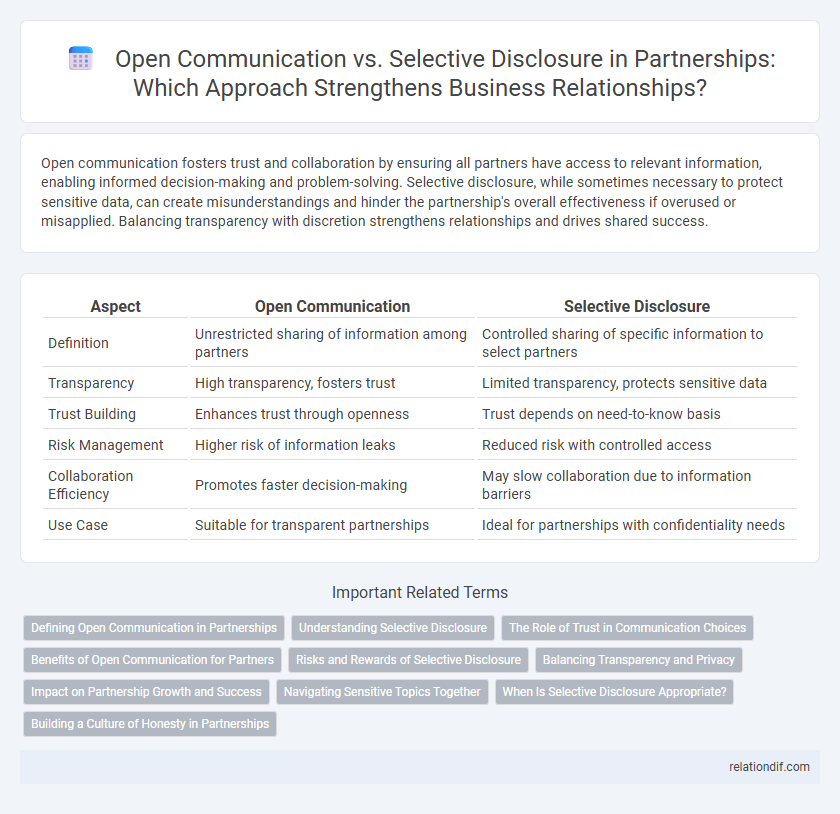Open communication fosters trust and collaboration by ensuring all partners have access to relevant information, enabling informed decision-making and problem-solving. Selective disclosure, while sometimes necessary to protect sensitive data, can create misunderstandings and hinder the partnership's overall effectiveness if overused or misapplied. Balancing transparency with discretion strengthens relationships and drives shared success.
Table of Comparison
| Aspect | Open Communication | Selective Disclosure |
|---|---|---|
| Definition | Unrestricted sharing of information among partners | Controlled sharing of specific information to select partners |
| Transparency | High transparency, fosters trust | Limited transparency, protects sensitive data |
| Trust Building | Enhances trust through openness | Trust depends on need-to-know basis |
| Risk Management | Higher risk of information leaks | Reduced risk with controlled access |
| Collaboration Efficiency | Promotes faster decision-making | May slow collaboration due to information barriers |
| Use Case | Suitable for transparent partnerships | Ideal for partnerships with confidentiality needs |
Defining Open Communication in Partnerships
Open communication in partnerships involves transparent, consistent sharing of relevant information to build trust and facilitate decision-making. It encourages honest dialogue where all parties feel heard and valued, promoting collaboration and conflict resolution. This approach contrasts selective disclosure, which limits information flow and can undermine mutual understanding and cooperation.
Understanding Selective Disclosure
Selective disclosure involves sharing specific information with partners to protect sensitive data while maintaining trust and collaboration. It requires careful judgment to balance transparency and confidentiality, ensuring that only relevant details are communicated to support mutual goals. This approach helps prevent information overload and safeguards competitive advantages within a partnership.
The Role of Trust in Communication Choices
Trust forms the foundation of open communication, enabling partners to share information freely and foster transparency. Selective disclosure occurs when trust is limited, prompting partners to withhold sensitive details to protect interests or prevent misunderstandings. Balancing openness and discretion is crucial for maintaining trust while navigating complex partnership dynamics.
Benefits of Open Communication for Partners
Open communication fosters transparency and trust, essential elements for a strong partnership. Partners benefit from timely information exchange, which enhances collaboration and decision-making efficiency. This approach reduces misunderstandings and strengthens long-term commitment between parties.
Risks and Rewards of Selective Disclosure
Selective disclosure in partnerships carries the risk of eroding trust and causing misunderstandings, potentially jeopardizing long-term collaboration. However, it can also provide strategic advantages by protecting sensitive information and maintaining competitive leverage. Balancing transparency with discretion is crucial to maximize benefits while mitigating the dangers of misinformation or mistrust.
Balancing Transparency and Privacy
Effective partnerships rely on balancing transparency through open communication while maintaining privacy by practicing selective disclosure. Sharing critical information fosters trust and collaboration, whereas withholding sensitive details protects competitive advantage and personal boundaries. Striking this balance ensures mutual respect and sustained partnership success.
Impact on Partnership Growth and Success
Open communication fosters trust and transparency, facilitating collaboration and long-term partnership growth by ensuring all parties are aligned and informed. Selective disclosure, while sometimes protecting sensitive information, can lead to misunderstandings, hinder decision-making, and create barriers that impede partnership success. Consistent, honest dialogue drives mutual respect and adaptability, critical factors in sustaining and expanding successful partnerships.
Navigating Sensitive Topics Together
Open communication fosters trust and transparency, enabling partners to address sensitive topics collaboratively without fear of misunderstanding or conflict. Selective disclosure strategically manages information flow, balancing openness with discretion to protect privacy and maintain harmony. Navigating sensitive topics together requires establishing clear boundaries and mutual respect to ensure both honesty and comfort in the partnership.
When Is Selective Disclosure Appropriate?
Selective disclosure is appropriate in partnerships when sharing sensitive information that could impact competitive advantage or violate confidentiality agreements. It ensures vital data is communicated only to relevant stakeholders who require the information for decision-making or strategic planning. This approach balances transparency with protection of proprietary knowledge, maintaining trust without compromising security.
Building a Culture of Honesty in Partnerships
Open communication fosters transparency and trust, essential for building a culture of honesty in partnerships, while selective disclosure risks creating misunderstandings and eroding confidence. Emphasizing regular, honest dialogue encourages collaboration and resolves conflicts effectively, strengthening partnership resilience. Establishing clear communication norms ensures all stakeholders are informed and engaged, promoting long-term partnership success.
Open Communication vs Selective Disclosure Infographic

 relationdif.com
relationdif.com